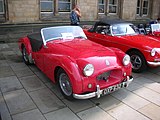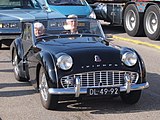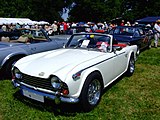
The Triumph Motor Company was a British car and motor manufacturing company in the 19th and 20th centuries. The marque had its origins in 1885 when Siegfried Bettmann of Nuremberg formed S. Bettmann & Co. and started importing bicycles from Europe and selling them under his own trade name in London. The trade name became "Triumph" the following year, and in 1887 Bettmann was joined by a partner, Moritz Schulte, also from Germany. In 1889, the businessmen started producing their own bicycles in Coventry, England.

The Triumph TR6 is a sports car that was built by the Triumph Motor Company of England. While production began several months earlier, the TR6 was officially introduced in January as a 1969 model year vehicle. The last TR6 was produced on the 20th of July 1976. Of the 91,850 TR6s produced, 83,480 were exported, almost all of them to the United States, while only 8,370 were sold in the UK.

The Standard Motor Company Limited was a motor vehicle manufacturer, founded in Coventry, England, in 1903 by Reginald Walter Maudslay. For many years, it manufactured Ferguson TE20 tractors powered by its Vanguard engine. All Standard's tractor assets were sold to Massey Ferguson in 1959. Standard purchased Triumph in 1945 and in 1959 officially changed its name to Standard-Triumph International and began to put the Triumph brand name on all its products. A new subsidiary took the name The Standard Motor Company Limited and took over the manufacture of the group's products.

The Triumph Dolomite small saloon car was produced by the Triumph Motor Company division of the British Leyland Corporation in Canley, Coventry between October 1972 and August 1980.

The Triumph TR8, eight-cylinder version of the "wedge-shaped" Triumph TR7 sports car was designed by Harris Mann and manufactured by British Leyland (BL), through its Jaguar/Rover/Triumph (JRT) division. Because of its outstanding performance, the TR8 was often dubbed the "English Corvette". The majority of TR8s were sold in the United States and Canada.

The Triumph TR4 is a sports car produced by the Triumph Motor Company from 1961 to 1965. Successor to the TR3A, the TR4's chassis and drivetrain are closely related to those of its predecessor, but with an updated body designed by Michelotti.

The Triumph slant-four is an inline four-cylinder petrol car engine developed by the Triumph Motor Company. It first appeared in 1968 in the Saab 99. The first Triumph model to use the engine did not appear until 1972. With an original capacity of 1.7 L, displacement grew over time to 2.0 L. Triumph production ended in 1981.

A trunnion is a cylindrical protrusion used as a mounting or pivoting point. First associated with cannons, they are an important military development.

The MGB is a two-door sports car manufactured and marketed from 1962 until 1980 by the British Motor Corporation (BMC), later the Austin-Morris division of British Leyland, as a four-cylinder, soft-top sports car. It was announced and its details first published on 19 September 1962. Variants include the MGB GT three-door 2+2 coupé (1965–1980), the six-cylinder sports car and coupé MGC (1967–69), and the eight-cylinder 2+2 coupé, the MGB GT V8 (1973–76).

The Triumph TR7 is a sports car that was manufactured in the United Kingdom from September 1974 to October 1981 by British Leyland Motor Corporation (BLMC), which changed its name to British Leyland (BL) in 1975. The car was launched in the United States in January 1975, with its UK home market debut in May 1976. The UK launch was delayed at least twice because of high demand for the vehicle in the US, with final sales of new TR7s continuing into 1982.
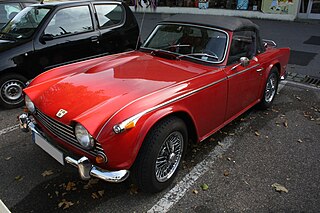
The Triumph TR5 is a sports car built by the Triumph Motor Company in Coventry, England, between August 1967 and September 1968.

The Triumph TR4A is a sports car built by the Triumph Motor Company at its Coventry factory in the United Kingdom between 1965 and 1967. It is an evolution of the Giovanni Michelotti styled TR4, with the TR4's Hotchkiss drive replaced by an independent rear suspension, indicated by an "IRS" badge attached to the car's rear.
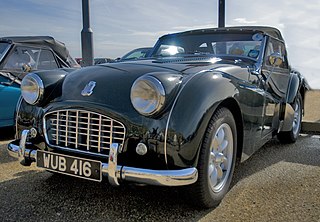
The Triumph TR3 is a British sports car produced between 1955 and 1962 by the Standard Motor Company of Coventry, England. A traditional roadster, the TR3 is an evolution of the company's earlier TR2 model, with greater power and improved braking. Updated variants, popularly but unofficially known as the "TR3A" and "TR3B", entered production in 1957 and 1962 respectively. The TR3 was succeeded by the Michelotti-styled, mechanically similar Triumph TR4.
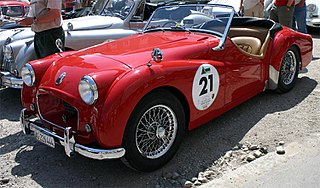
The Triumph TR2 is a sports car produced by the Standard Motor Company in the United Kingdom between 1953 and 1955. It was only available in roadster form.

The Triumph Roadster is a roadster produced by Britain's Standard Motor Company from 1946 until 1949. It was first available as the Triumph 1800 Roadster (18TR) from 1946 to 1948 and then as the Triumph 2000 Roadster (TRA) from 1948 to 1949.

The Triumph Mayflower is a small, upscale family car built from 1949 until 1953 by the British Standard Motor Company and sold by their Triumph Motor Company subsidiary. It has a 1+1⁄4-litre engine and was noted for its razor-edge styling. It was announced at the October 1949 British International Motor Show, but deliveries did not commence until the middle of 1950.
The Triumph 20TS was a prototype sports car shown by Standard-Triumph in October 1952 at the London Motor Show. Extensive development of the 20TS led to the introduction of the Triumph TR2 in March 1953 at the Geneva Motor Show, after which the 20TS was unofficially referred to as the Triumph TR1. Only one example of this car was ever made by Triumph.
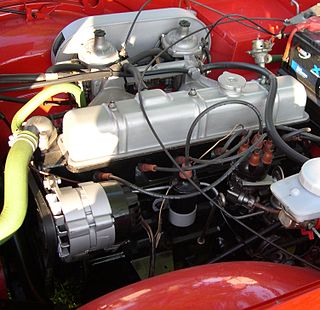
The Triumph Six Cylinder or Triumph I6 engine is a cast-iron overhead valve straight-six engine produced by Standard Triumph. It is an evolution of the Standard Motor Company's inline-4 Standard Eight, with the addition of two cylinders and a larger displacement.

The Triumph Fury is a two-door prototype drophead coupé commissioned by the Standard-Triumph Company of Coventry, England. It was the first Triumph sports car built on a unitary construction platform.
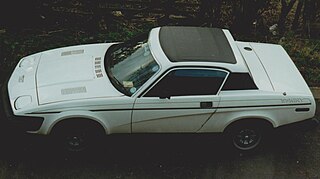
The Triumph TR7 Sprint version of the Triumph TR7 sports car was produced in 1977 by the Triumph Motor Company then part of British Leyland. However, it was produced in only very limited numbers: Probably a maximum of 61 in total were manufactured. It used the 127 bhp, 16-valve, 2-litre version of the Triumph slant-four engine from the Triumph Dolomite Sprint, a highly tuned version of which, "rated at 225 bhp at 8000 rpm" by 1977, was used in the Group 4 TR7 cars of the BL works rally team, from 1976 until 1978. This was instead of the TR7 base model's 105 bhp, 8-valve, 2-litre version of the same basic slant-4 engine. The 16-valve version was originally specified in the Dolomite Sprint at 135 bhp, and "Spenser King relates how he went away on holiday and came back to find an engine running on the bed giving 150 bhp at the first build."

